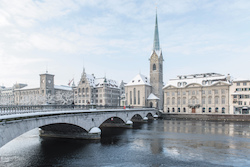Speaker
Dr
Henning Löwe
(WSL Institute for Snow and Avalanche Research SLF)
Description
It is well known that the mechanical behavior of snow highly depends on strain-rate as a consequence of the visco-plastic nature of ice. Accordingly, the mechanical response of snow is commonly believed to undergo a single transition from ductile to brittle behavior at a critical strain rate. A recent analysis of snow compression has however revealed the relevance of another time-scale associated to healing effects (e.g. sintering) during compression. The competition of healing and visco-plastic effects gives rise to a rich mechanical behavior in an intermediate range of strain rates. To further elaborate these phenomena we have conducted deformation-controlled compression experiments of low-density snow in a micro-compression stage operated in an X-ray tomography scanner. By varying the imposed axial strain rate over three orders of magnitude, we find a transition regime where the stress response suddenly changes from a smooth to quasi-oscillatory behavior, reminiscent of the Portevin–Le Chatelier effect. This regime of serrated flow is accompanied by compaction bands that nucleate in the interior of the sample as revealed by the tomography analysis. Our experimental results can be well explained within a minimal, scalar model for a rate-dependent, elasto-plastic constitutive law with healing. The model shows a negative slope of the stress vs strain-rate characteristic (strain rate softening) and correctly predicts the range of instability as well as the amplitude and frequency of the serrations. This dynamical instability has an interesting practical consequence, since the results suggest a mechanism how an initially homogeneous snow layer may spontaneously develop a sub-layer structure under deformation.
Significance statement
Serrated flow of snow resembles the Portevin–Le Chatelier effect where, in contrast, serrations are caused by competing dislocations. The observations demonstrate the importance of healing (sintering) which can fundamentally change the macroscopic mechanical behavior of snow.
Author
Dr
Henning Löwe
(WSL Institute for Snow and Avalanche Research SLF)
Co-authors
Prof.
Michael Zaiser
(University of Erlangen-Nuremberg)
Dr
Stefan Schleef
(WSL Institute for Snow and Avalanche Research SLF)

